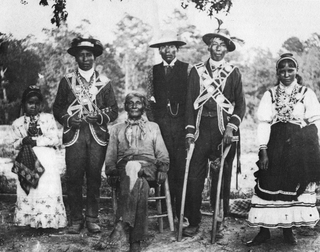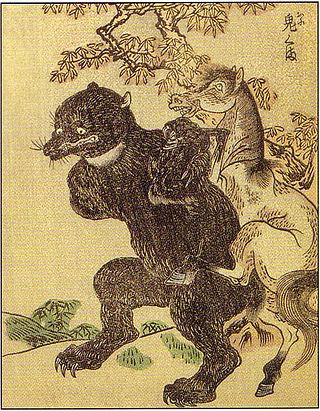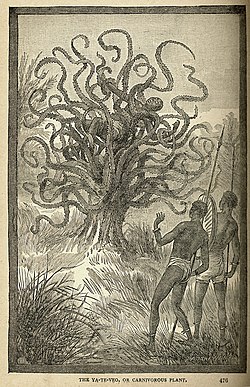
Coprophagia or coprophagy is the consumption of feces. The word is derived from the Ancient Greek κόπρος kópros "feces" and φαγεῖν phageîn "to eat". Coprophagy refers to many kinds of feces-eating, including eating feces of other species (heterospecifics), of other individuals (allocoprophagy), or one's own (autocoprophagy) – those once deposited or taken directly from the anus.

Pellucidar is a fictional Hollow Earth invented by American writer Edgar Rice Burroughs for a series of action adventure stories. In a crossover event, Tarzan, who was also created by Burroughs, visits Pellucidar.

Choctaw mythology is part of the culture of the Choctaw, a Native American tribe originally occupying a large territory in the present-day Southeastern United States: much of the states of Mississippi, Alabama, and Louisiana. In the 19th century, the Choctaw were known to European Americans as one of the "Five Civilized Tribes" even though controversy surrounds their removal.

An insectivore is a carnivorous animal or plant that eats insects. An alternative term is entomophage, which can also refer to the human practice of eating insects.

A kappa—also known as kawatarō, komahiki, with a boss called kawatora or suiko—is a reptiloid kami with similarities to yōkai found in traditional Japanese folklore. Kappa can become harmful when they are not respected as gods. They are typically depicted as green, human-like beings with webbed hands and feet and turtle-like carapaces on their backs. A depression on its head, called its "dish" (sara), retains water, and if this is damaged or its liquid is lost, the kappa is severely weakened.

Skull Island is the name most often used to describe a fictional island that first appeared in the 1933 film King Kong and later appearing in its sequels, the three remakes, and any other King Kong-based media. It is the home of the eponymous King Kong and several other species of creatures, mostly prehistoric and in some cases species that should have been extinct long before the rise of mammalian creatures, along with a primitive society of humans.

The Fourth Bear is a mystery/fantasy novel by Jasper Fforde published in July 2006. It is Jasper Fforde's sixth novel, and the second in the Nursery Crimes series. It continues the story of Detective Inspector Jack Spratt from The Big Over Easy.
Mythic humanoids are legendary, folkloric, or mythological creatures that are part human, or that resemble humans through appearance or character. Each culture has different mythical creatures that come from many different origins, and many of these creatures are humanoids. They are often able to talk and in many stories they guide the hero on their journey.

Carnivorous plants are plants that derive some or most of their nutrients from trapping and consuming animals or protozoans, typically insects and other arthropods, and occasionally small mammals and birds. They still generate all of their energy from photosynthesis. They have adapted to grow in waterlogged sunny places where the soil is thin or poor in nutrients, especially nitrogen, such as acidic bogs. They can be found on all continents except Antarctica, as well as many Pacific islands. In 1875, Charles Darwin published Insectivorous Plants, the first treatise to recognize the significance of carnivory in plants, describing years of painstaking research.
Human genetic chimerism, which can not only cause a wide range of illnesses but also lead to the same person having more than one profile in genetic fingerprinting, has served as a plot device in many works of fiction. Most known examples are subsequent to the 2004 book Free Culture, where author Lawrence Lessig digresses briefly to describe chimerism and suggest that it could, and had yet to, be well used as a television plot device.

An omnivore is an animal that has the ability to eat and survive on both plant and animal matter. Obtaining energy and nutrients from plant and animal matter, omnivores digest carbohydrates, protein, fat, and fiber, and metabolize the nutrients and energy of the sources absorbed. Often, they have the ability to incorporate food sources such as algae, fungi, and bacteria into their diet.

Vegetarianism in the Romantic Era refers to the rise of vegetarianism associated with the Romanticism movement in Western Europe from the eighteenth to the nineteenth century. Many of the late Romantics argued in favor of a more natural diet which excluded animal flesh for a plethora of reasons including the state of human and animal health, religious beliefs, economy and class division, animal rights, literary influence, as well as from new ideas about anthropology, consumerism, and evolution. The modern vegetarian and vegan movements borrow some of the same principles from the late Romantics to promote the adoption of diets free from animal products.

Venus Flytrap (also known as Body of the Prey is a 1970 American-Japanese science fiction horror film shot partly in Japan. It was distributed by the Toei Company of Japan. The film was released in Japan as Akuma no Niwa.
The Jubokko is a yōkai tree in Japanese folklore that appears in many books related to Japanese yōkai, including Shigeru Mizuki's works.

An onikuma is a mythological Japanese yōkai originating in the Kiso Valley in Nagano Prefecture. It is a bear-like creature that has been known to walk upright. They sneak into villages at night to carry off livestock for food. It was described in the Ehon Hyaku Monogatari, a collection of supernatural tales published in 1841.

Human uses of living things, including animals plants, fungi, and microbes, take many forms, both practical, such as the production of food and clothing, and symbolic, as in art, mythology, and religion. The skills and practices involved are transmitted by human culture through social learning. Social sciences including archaeology, anthropology and ethnography are starting to take a multispecies view of human interactions with nature, in which living things are not just resources to be exploited, practically or symbolically, but are involved as participants.

An Essay on Abstinence from Animal Food, as a Moral Duty is a book on ethical vegetarianism and animal rights written by Joseph Ritson, first published in 1802.














